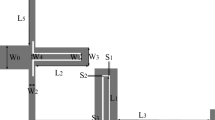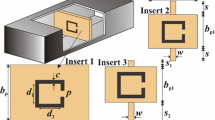Abstract
In this article, waveguide dual-band filter and diplexer working on W-band are synthesized through cascading mixed TE301- and TE102-mode cavities as well as TE101-mode resonators. Based on the discussion of top resonance modes in single cavity, the TE301&TE102 dual-mode resonator which features oversized dimension, technological insensitivity and high Q-factor is the strong candidate for designing high-frequency filters and diplexers. For dual-band filter, such dual-mode resonator can be shared by both bands as T-junction, and each band can be independently controlled. Besides, a W-band diplexer is proposed based on the analogous method. Two extra zeros have also been generated for each channel with adopting the singlet concept. Finally, the filter and diplexer prototypes are machined by CNC-milling. The filter has obtained 3-dB FBWs of 4% (86.7–90.2 GHz) and 6.3% (96.7–103 GHz), low insertion losses (ILs) of -0.9 dB and -0.5 dB, as well as less than -16 dB return loss, respectively. The diplexer has achieved 3-dB FBWs of 4.9% (86.3–90.6 GHz) and 6.5% (96.9–103.4 GHz), low ILs of -0.7 dB and -0.4 dB, high insolation with more than 40 dB, respectively. All the experimental results including transmission zeros on out-of-band are very close to the simulations in the full band. The performance of dual-band filter and diplexer is highlighted comparing with the reported ones too.













Similar content being viewed by others
Data availability
The data that support the findings of this study are available from the corresponding author upon reasonable request.
References
A. Wootten and A. R. Thompson, “The Atacama large millimeter/ submillimeter array,” Proc. IEEE, vol. 97, no. 8, pp. 1463–1471, Aug. 2009.
D. Cuadrado-Calle, P. Piironen and N. Ayllon, “Solid-state diode technology for millimeter and submillimeter-wave remote sensing applications: current status and future trends,” IEEE Microw. Mag., vol. 23, no. 6, pp. 44-56, Jun. 2022.
P. Heydari, H. Wang, H. Mohammadnezhad and P. Nazari, “Energy efficient 100+ GHz transceivers enabling beyond-5G wireless communications,” IEEE Wireless Commun., vol. 28, no. 1, pp. 144-151, Feb. 2021.
V. Camarchia et al., “A review of technologies and design techniques of millimeter-wave power amplifiers,” IEEE Trans. Microw. Theory Techn., vol. 68, no. 7, pp. 2957–2983, Jul. 2020.
J.-Q. Ding, J. Hu, and S.-C. Shi, “350 GHz Bandpass filters using superconducting coplanar waveguide,” IEEE Trans. Terahertz Sci. Technol., vol. 12, no. 5, pp. 548~556, 2021.
Z. Tan, Q.-Y. Zhang, Y.-L. Lei, Y. Zhao, and J.-Q. Ding, “Terahertz waveguide multiplexers: A review,” Microw. Opt. Technol. Lett. vol. 65, no. 7, pp. 1925–1935, 2023.
J. Ding, Y. Zhao, J.-X. Ge, and S. Shi, “A 90° waveguide hybrid with low amplitude imbalance in full W-band,” J. Infrared Milli. THz Waves, vol. 40, no. 4, pp. 429–434, 2019.
K.-D. Xu, et al., “Compact millimeter-wave on-chip dual-band bandpass filter in 0.15-μm GaAs technology,” IEEE J. Electron Devi., vol. 10, pp. 152-156, Jan. 2022.
K. Zhou, C.-X. Zhou, and W. Wu, “Substrate-integrated waveguide dual-band filters with closely spaced passbands and flexibly allocated bandwidths,” IEEE Trans. Compon. Packag. Manuf. Technol., vol. 8, no. 3, pp. 465–472, Mar. 2018.
K. Zhou, C. -X. Zhou and W. Wu, "Resonance characteristics of substrate-integrated rectangular cavity and their applications to dual-band and wide-stopband bandpass filters design," IEEE Trans. Micro. Theory Techn., vol. 65, no. 5, pp. 1511–1524, May. 2017.
K. Zhou and K. Wu, "Substrate integrated waveguide multiband bandpass filters and multiplexers: current status and future outlook," IEEE J. Microwaves, vol. 3, no. 1, pp. 466-483, Jan. 2023.
G. Xu, and M. Skorobogatiy, “Wired THz communications,” J. Infrared Milli. THz Waves, vol. 43, no. 4, pp. 728–778, 2022.
T. Kojima et al., “275–500-GHz wideband waveguide SIS mixers,” IEEE Trans. Terahertz Sci. Technol., vol. 8, no. 6, pp. 638–646, Oct. 2018.
S. Bryan, et al., “A compact filter-bank waveguide spectrometer for millimeter wavelengths,” IEEE Trans. Terahertz Sci. Technol., vol. 5, no. 4, pp. 598–604, Jul. 2015.
X. Cao, Z. Tang, and J. Bao, “Design of a dual-band waveguide filter based on micromachining fabrication process,” IET Microw. Antennas Propag., vol. 10, no. 4, pp. 459–463, 2016.
J.-P. Duan, X.-X. Shen, H. **ao, B.-Z. Zhang and Q. Bai, “Micromachined W-band dual-band quasi-elliptic waveguide filter,” Microelectronics J., vol. 115, pp. 1-4, Aug. 2021.
Y. Huang et al., "A WR 3 dual band bandpass filter based on parallel coupling structure," Microsyst. Technol., vol. 23, pp. 2553-2559, Jun. 2016.
X. Shang, M. Ke, Y. Wang and M. J. Lancaster, “WR-3 band waveguides and filters fabricated using SU-8 photoresist micromachining technology,” IEEE Trans. Terahertz Sci. Technol., vol. 2, no. 6, pp. 629-637, Nov. 2012.
K. Zhou, J. -Q. Ding, C. -X. Zhou and W. Wu, “W-band dual-band quasi-elliptical waveguide filter with flexibly allocated frequency and bandwidth ratios,” IEEE Microw. Wireless Compon. Lett., vol. 28, no. 3, pp. 206-208, Mar. 2018.
J. Chen, S. Zhang, C. Zhang and Y. Li, “W-band dual-band waveguide band-pass filter using dual-mode cavities,” Electron. Lett., vol. 54, no. 25, pp. 1444-1446, Dec. 2018.
C. Bartlett and M. Höft, “Dual-mode dual-band bandpass filter design utilizing cylindrical TM-mode cavities,” Electron. Lett., vol. 57, no. 8, pp. 328-330, Apr. 2021.
C. Bartlett and M. Höft, "Fully inline and symmetric dual-mode dual-band bandpass filters for millimetre-wave applications," in IEEE MTT-S International Microwave Filter Workshop (IMFW), Nov. 2021, pp. 323–325.
Y. -L. Cheng, H. -W. Chen, P. -D. Huang and C. -Y. Chang, "A W-band quadrature hybrid coupled substrate integrated waveguide diplexer," in Asia-Pacific Microwave Conference (APMC), Dec. 2015, pp. 1–3.
T. Kojima, A. Gonzalez, S. Asayama, and Y. Uzawa, “Design and development of a hybrid-coupled waveguide multiplexer for a multiband receiver,” IEEE Trans. Terahertz Sci. Technol., vol. 7, no. 1, pp. 10-19, Jan. 2017.
A. Morini, G. Venanzoni, M. Farina and T. Rozzi, “Practical design of a high-power tuning-less W-band triplexer for ground radar surveillance systems,” IET Microw., Antennas Propag., vol. 1, no. 4, pp. 822–826, Mar. 2007.
C. Bartlett, J. Bornemann, and M. Höft, “3D-Printing and high precision milling of W-band filter components with admittance inverter sequences,” IEEE Trans. Compon. Packag. Manuf. Technol., vol. 11, no. 12, pp. 2140–2147, Dec. 2021.
X. Zhao et al., “Silicon micromachined D-band diplexer using releasable filling structure technique,” IEEE Trans. Micro. Theory Tech., vol. 68, no. 8, pp. 3448-3460, Aug. 2020.
Y. Yu et al., “D-band waveguide diplexer fabricated using micro laser sintering,” IEEE Trans. Compon. Packag. Manuf. Technol., vol. 12, no. 9, pp. 1446–1457, Sep. 2022.
C. Bartlett, O. Glubokov, F. Kamrath and M. Höft, “Highly selective broadband mm-wave diplexer design,” IEEE Micro. Wireless Compon. Lett., Sep. 2022.
J.-Q. Ding, S.-C. Shi, K. Zhou, Y. Zhao, D. Liu, and W. Wu, “WR-3 band quasi-elliptical waveguide filters using higher order mode resonances,” IEEE Trans. Terahertz Sci. Technol., vol. 7, no. 3, pp. 302–309, May 2017.
J.-Q. Ding, S.-C. Shi, K. Zhou, D. Liu, and W. Wu, “Analysis of 220-GHz low-loss quasi-elliptic waveguide bandpass filter,” IEEE Microw. Wireless Compon. Lett., vol. 27, no. 7, pp. 648–650, Jul. 2017.
S. Groiss, “Numerical analysis of lossy cavity resonators,” Ph.D. dissertation, Tech. Univ. Graz, Graz, Austria, Jun. 1996.
J.-S. Hong and M. J. Lancaster, Microstrip Filters for RF/Microwave Applications. New York, NY, USA: Wiley, 2001, chs. 8–10.
Y. **ao, P. Shan, K. Zhu, H. Sun and F. Yang, “Analysis of a novel singlet and its application in THz bandpass filter design,” IEEE Trans. Terahertz Sci. Technol., vol. 8, no. 3, pp. 312–320, May. 2018.
S. Bastioli and R. V. Snyder, “Nonresonating modes do it better!: Exploiting additional modes in conjunction with operating modes to design better quality filters,” IEEE Micro. Mag., vol. 22, no. 1, pp. 20-45, Jan. 2021.
Funding
1. National Natural Science Foundation of China under Grant 12003011.
2. State Key Laboratory of Millimeter Waves Open Research Program under Grant K202417.
Author information
Authors and Affiliations
Contributions
Jiang-Qiao Ding: Funding acquisition, Investigation, Project administration, Writing-original draft, Rong-Huai Nie: Investigation, Methodology, Software, Writing-original draft, Yun Zhao: Conceptualization, Data curation, Formal analysis, Jun Jiang: Supervision, Validation, Visualization, Kun Huang: Supervision, Validation, Visualization, Sheng Li: Funding acquisition, Project administration, Supervision.
Corresponding author
Ethics declarations
Competing interests
The authors declare no competing interests.
Ethical Approval
Not applicable.
Conflict of interest
The authors declare no conflicts of interest.
Additional information
Publisher's Note
Springer Nature remains neutral with regard to jurisdictional claims in published maps and institutional affiliations.
Rights and permissions
Springer Nature or its licensor (e.g. a society or other partner) holds exclusive rights to this article under a publishing agreement with the author(s) or other rightsholder(s); author self-archiving of the accepted manuscript version of this article is solely governed by the terms of such publishing agreement and applicable law.
About this article
Cite this article
Ding, JQ., Nie, RH., Zhao, Y. et al. W-band Dual-band Filter and Diplexer Based on Mixed TE301- and TE102-Mode Cavities. J Infrared Milli Terahz Waves 45, 556–573 (2024). https://doi.org/10.1007/s10762-024-00989-8
Received:
Accepted:
Published:
Issue Date:
DOI: https://doi.org/10.1007/s10762-024-00989-8




